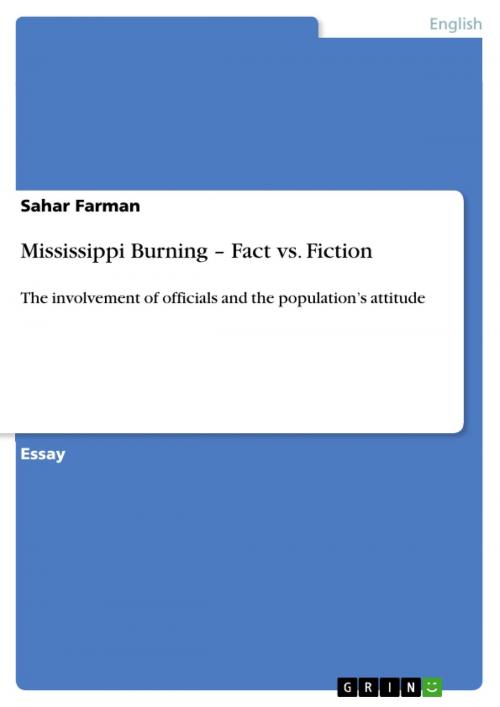Mississippi Burning - Fact vs. Fiction
The involvement of officials and the population's attitude
Nonfiction, Entertainment, Drama, Anthologies| Author: | Sahar Farman | ISBN: | 9783640160617 |
| Publisher: | GRIN Publishing | Publication: | September 10, 2008 |
| Imprint: | GRIN Publishing | Language: | English |
| Author: | Sahar Farman |
| ISBN: | 9783640160617 |
| Publisher: | GRIN Publishing |
| Publication: | September 10, 2008 |
| Imprint: | GRIN Publishing |
| Language: | English |
Essay from the year 2007 in the subject American Studies - Miscellaneous, grade: keine, University of Marburg, 4 entries in the bibliography, language: English, abstract: Alan Parker's movie Mississippi Burning is set in a small town in the state of Mississippi. The plot of the movie plays in 1964 when the three civil rights activists Michael Schwerner, Andrew Goodman and James Chaney, traveling in a car at night, are forced off the road and out of their car and shot by members of the Ku-Klux-Klan. The FBI is put on the case and two agents - a younger FBI-academy agent and a small town agent - travel to Meridian to examine the case, after having been informed of the disappearance. The two agents then call for more manpower to solve the case despite the difficulties they encounter with the state officials. The investigation leads to tensions between the small town community and the FBI agents and the situation between the Ku-Klux-Klan and the black population escalates. The agents finally find the vehicle of the three civil rights workers in a swamp. In order to find the bodies Klan members including the mayor are interviewed and eventually forced by dingy methods to reveal the location of the bodies. In the last sequence of the movie most of the members are convicted and sent to prison. Only one member is acquitted. The movie revealed a glimpse of the involvement of high rank officials in the case and the attitude of the population of Mississippi toward the burnings, the killings and the investigation. It is yet to be examined whether both the involvement and the attitude are used as dramatic elements or represent the actual situation in small towns in 1964 Mississippi. Despite the fact that the latter, meaning the attitude, is harder to be examined, both aspects have to be taken into consideration, in order to be able to get an impression of the situation of small town Mississippi in the mid sixties. According to all the documents collected within the long investigation for the several trials that followed the case, it is true that a lot of high rank officials were involved. In the movie the civil rights workers are stopped and shot by a sheriff driving a patrol car.
Essay from the year 2007 in the subject American Studies - Miscellaneous, grade: keine, University of Marburg, 4 entries in the bibliography, language: English, abstract: Alan Parker's movie Mississippi Burning is set in a small town in the state of Mississippi. The plot of the movie plays in 1964 when the three civil rights activists Michael Schwerner, Andrew Goodman and James Chaney, traveling in a car at night, are forced off the road and out of their car and shot by members of the Ku-Klux-Klan. The FBI is put on the case and two agents - a younger FBI-academy agent and a small town agent - travel to Meridian to examine the case, after having been informed of the disappearance. The two agents then call for more manpower to solve the case despite the difficulties they encounter with the state officials. The investigation leads to tensions between the small town community and the FBI agents and the situation between the Ku-Klux-Klan and the black population escalates. The agents finally find the vehicle of the three civil rights workers in a swamp. In order to find the bodies Klan members including the mayor are interviewed and eventually forced by dingy methods to reveal the location of the bodies. In the last sequence of the movie most of the members are convicted and sent to prison. Only one member is acquitted. The movie revealed a glimpse of the involvement of high rank officials in the case and the attitude of the population of Mississippi toward the burnings, the killings and the investigation. It is yet to be examined whether both the involvement and the attitude are used as dramatic elements or represent the actual situation in small towns in 1964 Mississippi. Despite the fact that the latter, meaning the attitude, is harder to be examined, both aspects have to be taken into consideration, in order to be able to get an impression of the situation of small town Mississippi in the mid sixties. According to all the documents collected within the long investigation for the several trials that followed the case, it is true that a lot of high rank officials were involved. In the movie the civil rights workers are stopped and shot by a sheriff driving a patrol car.















